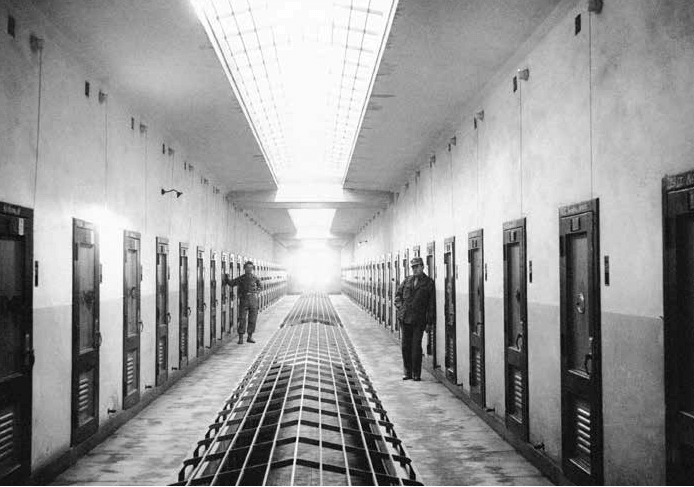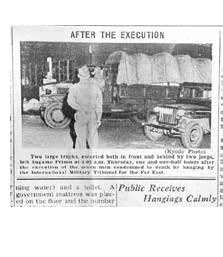Issue:

U.S. Army guards in Sugamo Prison, December 1945.
AP PHOTO/JIM WELLS
The secret journey of General Tojo’s ashes
Why were the remains of Japan’s former leader spirited away in the middle of the night? And where were they
by EIICHIRO TOKUMOTO
The weather was frigid and overcast, threatening snow. On the evening of Dec. 22, 1948, shortly before Christmas, a large phalanx of men had gathered outside the gate of Tokyo’s Sugamo Prison. The crowd was made up of journalists and exhausted photographers who’d been staked out there for over ten days. It appeared nearly all of them were nursing small bottles of whiskey or other types of liquid sustenance.
Midnight passed, and still they waited. Shortly after 2:00 am, two large canopied army trucks emerged from the prison’s main gate, escorted by jeeps of the U.S. Military Police. Immediately, the men came to attention as a successive burst of camera flashes lit the scene. One excited Japanese reporter sneaked up to peek into the bed of one of the trucks and shouted, “Kanoke da! Kanoke da zo!” (Coffins! They’re coffins!).
The trucks sped into the night with their jeep escorts fore and aft, as a few of the excited reporters took off in pursuit. One of the jeep drivers was Tokyo Correspondents’ Club (the precursor of the FCCJ) member Richard C. Ferguson of ACME News Pictures. Seated beside him in the passenger’s seat was his friend, Sun News Photo Agency photographer Koji Shiroyama. The trucks they pursued were carrying the corpses of seven ClassA war criminals, including that of former Prime Minister Hideki Tojo, who had been hanged ninety minutes earlier.
FOLLOWING JAPAN’S SURRENDER IN August 1945, the Occupation commenced under the Supreme Commander Allied Forces, General of the Army Douglas MacArthur. From his General Headquarters in Yurakucho, the general oversaw the huge job of Japan’s demilitarization and democratization. One event under his administration captured the world’s attention: the International Military Tribunal for the Far East, also referred to as the Tokyo War Crimes trial.
The instigators of Japan’s acts of aggression from the time of the so called Manchurian Incident to the Pacific War were put on trial in the name of international justice. By the time the proceedings came to a close, they amounted to 416 court sessions over a two and a half year period from May 1946.
The Tokyo tribunal and the trials of the former Nazi leaders in Nuremberg, Germany, were described as “the trials of the century.” At their conclusion on Nov. 12, 1948, Australian judge Sir William Webb pronounced the death sentence on seven defendants, including former PM Tojo, former Foreign Minister Koki Hirota and Army General Iwane Matsui.
The executions of the once powerful men were carried out under the orders of Gen. MacArthur at Sugamo Prison on Dec. 23. (Coincidentally or perhaps not it also happened to be the 15th birthday of Prince Tsugu, who from 1952 became known as Crown Prince Akihito, and from 1989 became the present emperor.)
Of course, the members of the newly established Tokyo Correspondents’ Club had covered the court proceedings in much detail. So it was no surprise that on the evening of Dec. 22, both at the Club and outside the prison, the main topic of conversation was where the remains of Tojo and the others would be transported, and how they were to be disposed of.
In fact, few were to know what really happened until Koji Shiroyama published his memoirs some five years later.
WHEN THE TRUCKS HAULING the bodies left the prison, they took National Route 1 in the direction of Yokohama, with Ferguson and Shiroyama among the several reporters’ vehicles in pursuit. One of the jeeps abruptly stopped and two MPs got out, brandishing their rifles. They shouted out a command to “Halt!” which was cause enough for most of the reporters to turn back. But Ferguson and Shiroyama disregarded the command and continued following the trucks.
But somewhere along the way they lost the trail, and things looked bleak until they came up with the idea to stop at a local police station and ask for directions to the local crematorium. After a Japanese detective pointed out that one was nearby, atop one of Yokohama’s many hills, the two hopped back in their jeep and made a beeline for the spot. Just as dawn was breaking, they ascended the slope of a hill, where they noticed gray smoke being emitted from a tall chimney. The trucks and MP’s jeeps that managed to elude them earlier were parked in front of the building, which turned out to be the Yokohama Municipal Crematorium in Kuboyama.
The two observed as the Japanese crematorium staff loaded what looked like cinerary urns onto the trucks. After the trucks and their jeep escorts roared away in a cloud of dust, the two men walked into the building. The staff seemed to think Ferguson was a member of the U.S. military and the two men went along with it. When the staff made no move to stop them, the two began snapping photographs of the scene.
As Shiroyama wrote in his memoir, “Above eight pots lined up at the crematorium was a blackboard, on which the names ‘Tojo,’ ‘Kymura’ and so on appeared in strangely spelled Roman letters. I was so excited I could feel my heart beating as I released the shutter, again and again.
“The lid on the pot labeled ‘Tojo’ was open, and flames could still be seen rising from the few remaining embers. Through the smoke could be seen fragments of white bone.”

The pots, however, were largely empty, so there was no mistake about it: the trucks had carried off the ashes of the seven Class A war criminals. But where and how were those ashes disposed of? At the time it was all treated as a closely guarded secret; even now, the facts are cloudy. So why was GHQ so uneasy about the location of the remains?
THE REASON FOR THEIR concern can be found in the declassified records of GHQ. Two months after the signing of the San Francisco Peace Treaty, in November 1951, a Japanese man, who appeared to be acting on behalf of Tojo’s wife, petitioned GHQ for the return of the seven executed men’s ashes. The record of a meeting of the G2 Military Intelligence Section, General Staff, held on Nov. 26, 1951, contained this passage:
“. . . it was the consensus of this group that any such action would be extremely inadvisable for the following three reasons: a. Such action would be in effect reversing ourselves in our long established policy re war criminals; b. We would be providing a made to order rallying point and cause for a resurgent Japanese ultra nationalism; and c. We would probably alienate more Japanese than we would possibly win to our side, since it is believed that the majority of Japanese at present consider TOJO (and probably the others as well) as a betrayer rather than as a hero . . . it was suggested that if an answer is made to this request the answer should take the line that the remains of the persons involved were irretrievably destroyed.”
In the view of GHQ then, Tojo and the other Class A war criminals were viewed as a threat even after their deaths, and the whereabouts of their remains had to be treated as a closely guarded secret.
Returning to Tokyo from the Yokohama crematorium, Ferguson and Shiroyama drove to Tojo’s residence in Setagaya Ward. Ferguson presented his business card to one of the family’s maids, and Tojo’s wife, Katsuko, invited them into a tatami floored reception room, where she gave them an exclusive interview.
According to Shiroyama, Ferguson seemed quite agitated. In a low voice he repeatedly said to his fellow photographer, “Please tell her to forgive me. Again, please tell her to forgive me.” To which Katsuko Tojo firmly replied, “It’s not personal. Please do your job.”
Ferguson and Shiroyama requested Katsuko and Tojo’s son and daughter to pose for a photo before the family’s Buddhist altar, but Katsuko resolutely refused, saying “I cannot turn my back toward my dead husband.” Then the two explained to the family what they had witnessed at the Yokohama crematorium, while the family listened in silence, their heads hanging in resignation.
Shiroyama was later to admit in his memoir, “I felt very bad for not having taken even a small amount of his ashes from the pot and bringing it to them.
SO WHAT WAS THE final destination of the remains of the Class A war criminals? A hint to the answer may be found in a dispatch from UP (the forerunner of UPI) filed immediately after their executions by longtime FCCJ member and UP correspondent at the time, Ian Mutsu, who wrote:
“Wood and coal fire in seven rusty ovens consumed the remains of the former top ranking leaders of Japan amid surroundings that offered no more dignity than a common garbage incinerator. . . . The strictest security regulations were applied to guard the bodies en route and also at the American cemetery.
“A truck, presumably carrying the ashes of the seven executed Class A war criminals, left the Yokohama Municipal Crematorium under jeep escort in the direction of the United States Army Cemetery at Yaguchidai, Naka Ward, Yokohama.”
The location of the U.S. Army Cemetery at Yaguchidai was some 4.3 kilometers away from the crematorium. It is currently the site of the Yokohama Country & Athletic Club (YCAC), a membership sports club originally founded by British residents in 1868. Immediately following the war’s end, the club’s land was requisitioned by GHQ for use as a U.S. Armed Forces Cemetery.
At some point, rumors began circulating among members of the club that the remains of Tojo and the others had been disposed of in a marshy area on YCAC property. Today, long standing YCAC members familiar with the story will tell you the remains were scattered in what is now a parking lot adjacent to the tennis court.
The two organizations, the FCCJ and the YCAC, now maintain a reciprocal arrangement. There may be some irony in the fact that while members of the former pursued the remains of the Class A war criminals 67 years ago, it was the latter that provided the place where their ashes were laid to rest.
The former site of the Sugamo Prison gallows can be visited in a small park just north of Ikebukuro’s Sunshine 60 complex. It is marked with a stone bearing the inscription, Eikyu heiwa wo negatte (“Wishing for eternal peace”).
Eiichiro Tokumoto, a former Reuters correspondent, is an author and investigative journalist.

